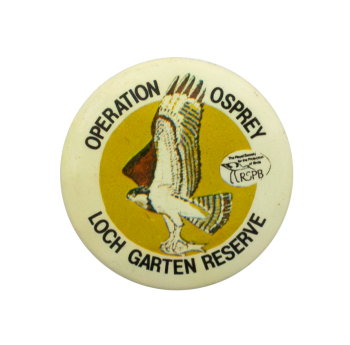| Category | |
|---|---|
| Additional Images | |
| Sub Categories | |
| Text on Button | OPERATION OSPREY LOCH GARTEN RESERVE The Royal Society for the Protection of Birds RSPB |
| Image Description | Off-white border and black text with a dark yellow center and a brown and white illustration of an osprey in the center foreground |
| Curl Text | AMALCO made in Britain THE ROYAL SOCIETY FOR THE PROTECTION OF BIRDS |
| Back Style | |
| The Shape | |
| The Size | |
| Additional Information | Originally founded as the Plumage League in 1889 by Emily Williamson, the Royal Society for the Protection of Birds (RSPB) started as a campaign against the use of feathers in fashion that were driving birds to extinction. The all-women movement was born out frustration that the male-only British Ornithologists Union was not taking the issue seriously. In 1904, the group was officially awarded the Royal Charter, making it a Royal Society and marking the name change to RSPB. In 1921, the Importation of Plumage (Prohibition) Act was instated in the United Kingdom making it the first successful nature campaign for RSPB. RSPB works to promote the conservation and protection of birds and the environment through the operation of nature reserves throughout the UK. Today, it is one of the world’s largest conservation organizations with over a million members. The Loch Garten Reserve located in Scotland, houses the Osprey Center and was purchased by charity through the RSPB. It is a bird-watching facility that focuses on a nesting pair of ospreys. An osprey is a large, long-winged hawk that lives near seacoasts or large waterways where it flies over the water to hunt fish. They are also nicknamed the fish hawk. Ospreys are just one bird that was almost wiped out to extinction due to careless behavior of humans in the UK (and around the world) in the 19th and 20th century. However, in 1954, out of their own accord two Ospreys began nesting in the Loch Garten Reserve and slowly helped recolonize the species in Scotland. In 1959, the pair successfully began breeding which was also the birth of RSPB’s Operation Osprey. The goal was to raise awareness and support to monitor and protect the pair (and other Ospreys). In 2019, the original pair were no longer breeding in the reserve. However, good news came in 2022, when a new pair took over the reserve to nest and successfully began to raising their young. |
| Sources |
Britannica, T. Editors of Encyclopedia (2024, January 3). Osprey. Encyclopedia Britannica. https://www.britannica.com/animal/osprey-bird Ramage, T. (2022, July 15). Delight as new osprey chicks ringed at RSPB Loch Garten Nature Centre. The Northern Times. https://www.northern-times.co.uk/news/osprey-chicks-delight-at-loch-garten-281568// Rare Bird Alert. (2019, July 10). RSPB Scotland celebrates 60 years of Loch Garten Ospreys - and you are invited. Rare Bird Alert. https://www.rarebirdalert.co.uk/v2/Content/RSPB_Scotland_celebrates_60_years_of_Loch_Garten_Osprey_Centre_and_you_are_invited.aspx?s_id=868417882#:~:text=This%20protection%20and%20public%20engagement,the%20UK%20would%20be%20secured. Royal Protection Of Birds. (n.d.). Our History. RSPB UK. https://www.rspb.org.uk/about-us/our-history |
| Catalog ID | CA0924 |


